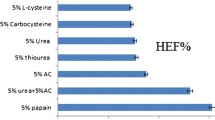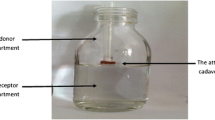Abstract
The aim of present investigation was to develop transungual drug delivery system (nail lacquer) of terbinafine hydrochloride for treatment of onychomycosis. Different types of penetration enhancers, viz. 2-mercaptoethanol, n-acetyl-l-cysteine and thioglycolic acid, were evaluated to determine their effect on drug permeation. Various types of polymers, both hydrophobic (Eudragit® RL 100 and Eudragit® RS 100) and hydrophilic polymers (hydroxypropyl methyl cellulose (HPMC) E15), were evaluated for their film-forming and drug permeation characteristics. The nail lacquer was optimised statistically by applying 32 full factorial design. Polymer ratio (Eudragit® RL 100/HPMC E15; X 1) and solvent ratio (ethanol/water; X 2) were selected as independent variable, and viscosity (cPs), nail plate hydration (%) and in vitro drug permeated at the end of 24 h (μg/cm2) were selected as dependent variable. The optimised batch comprises of polymer ratio (70:30) and solvent ratio (75:25). Ex vivo drug permeation study was performed using human cadaver toe nail plate. The results revealed that the amount of drug permeated at the end of 24 h was 61.55 ± 3.2 μg/cm2, which was found to be higher than the minimum inhibitory concentration of drug. This study confirms that the developed drug-loaded nail lacquer could be used as a promising tool for the effective treatment of onychomycosis.








Similar content being viewed by others
References
Murdan S. Drug delivery to the nail following topical application. Int J Pharm. 2002;236:1–26.
Barot BS, Parejiya PB, Patel HK, Gohel MC, Shelat PK. Microemulsion-based gel of terbinafine for the treatment of onychomycosis: optimization of formulation using D-optimal design. AAPS PharmSciTech. 2012;13:184–92.
Elewski BE. Onychomycosis: pathogenesis, diagnosis, and management. Clin Microbiol Rev. 1998;11:415–29.
Leelavathi M, Tzar MN, Adawiah J. Common microorganisms causing onychomycosis in tropical climate. Sains Malaysiana. 2012;41:697–700.
Roberts DT, Taylor WD, Boyle J. Guidelines for treatment of onychomycosis. Br J Dermatol. 2003;148:402–10.
Gelotar P, Vachhani S, Patel B, Makwana N. The prevalence of fungi in fingernail onychomycosis. J Clin Diagn Res. 2013;7:250–2.
British Pharmacopoeia. Terbinafine hydrochloride. Monographs of Medicinal and Pharmaceutical Substances, volumed I and II, 2009.
http://www.usp.org/sites/default/files/usp_pdf/EN/USPNF/TerbinafineHydrochlorideRevisionBulletin.pdf. Accessed 11 Dec 2013.
http://www.drugbank.ca/drugs/DB00857. Accessed 18 Dec 2013.
www.medicines.org.uk. Accessed 18 Dec 2013.
Firoz S, Sirisha MN, Rajalakshmi R. Transungual drug delivery system—a review. Int J Innov Drug Deliv. 2011;1:9–14.
Chandra R, Kumar S, Aggarwal A. Evaluation of nail lacquer. Indo Glob J Pharm Sci. 2012;2:379–82.
Hao J, Smith KA, Kevin S. Chemical method to enhance transungual transport and iontophoresis efficiency. Int J Pharm. 2008;357:61–9.
Khengar RH, Jones SA, Turner RB, Forbes B, Brown MB. Nail swelling as a pre-formulation screen for the selection and optimisation of ungual penetration enhancers. Pharm Res. 2007;24:2207–12.
Murdan S. Enhancing the nail permeability of topically applied drugs. Expert Opin Drug Deliv. 2008;5:1267–82.
Monti D, Saccomani L, Chetoni P, Burgalassi S, Tampucci S, Mailland F. Validation of bovine hoof slices as a model for infected human toenails: in vitro ciclopirox transungual permeation. Br J Dermatol. 2011;165:99–105.
Kobayashi Y, Miyamoto M, Sugibayashi K, Morimoto Y. Drug permeation through the three layer of the human nail plate. J Pharm Pharmacol. 1999;51:271–8.
Mertin D, Lippold BC. In-vitro permeability of the human nail and of a keratin membrane from bovine hooves: influence of the partition coefficient octanol/water and the water solubility of drugs on their permeability and maximum flux. J Pharm Pharmacol. 1997;49:30–4.
Rajendra VB, Baro A, Kumari A, Dhamecha DL, Lahoti SR, Shelke SD. Transungual drug delivery: an overview. J Appl Pharm Sci. 2012;02:203–9.
Murthy SN, Vaka SR, Sammeta SM, Nair AB. TranScreen-N: method for rapid screening of trans-ungual drug delivery enhancers. J Pharm Sci. 2009;98:4264–71.
Joseph M, Bruce G. Composition containing citric acid for the treatment of nail fungal infections. EP 1545429 B1 2010.
Patel MM, Amin AF. Design and optimization of colon-targeted system of theophylline for chronotherapy of nocturnal asthma. J Pharm Sci. 2011;100:1760–72.
Nogueiras-Nieto L, Gómez-Amoza JL, Delgado-Charro MB, Otero-Espinar FJ. Hydration and n-acetyl-l-cysteine alter the microstructure of human nail and bovine hoof: implications for drug delivery. J Control Release. 2011;156:337–44.
Silverstein R, Webster F, Kiemle D. Spectrometric identification of organic compound. New Jersey: John Wiley & Sons Inc; 2005.
Alsterholm M, Karami N, Faergemann J. Antimicrobial activity of topical skin pharmaceuticals—an in vitro study. Acta Derm Venereol. 2010;90:239–45.
Osborne CS, Hofbauer B, Favre B, Ryder NS. In vitro analysis of the ability of Trichophyton rubrum to become resistant to terbinafine. Antimicrob Agents Chemother. 2003;47:3634–6.
Author information
Authors and Affiliations
Corresponding author
Ethics declarations
Conflict of interest
The authors declare that they have no conflict of interest.
Rights and permissions
About this article
Cite this article
Patel, M.M., Vora, Z.M. Formulation development and optimization of transungual drug delivery system of terbinafine hydrochloride for the treatment of onychomycosis. Drug Deliv. and Transl. Res. 6, 263–275 (2016). https://doi.org/10.1007/s13346-016-0287-x
Published:
Issue Date:
DOI: https://doi.org/10.1007/s13346-016-0287-x




